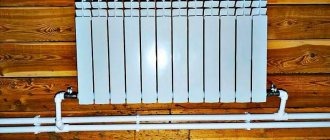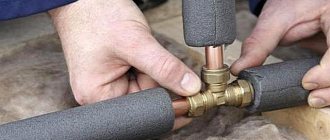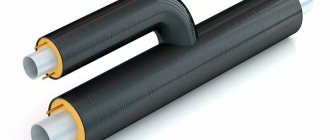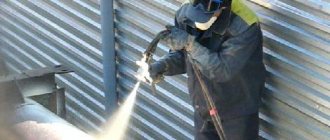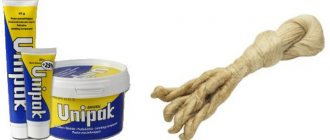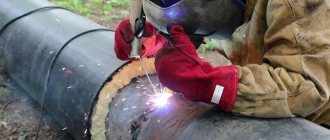The walls of the pipelines through which the coolant flows are always heated to a certain temperature. Its value depends on the material of the pipes; steel ones heat up more, plastic ones - less. But in any case, due to this phenomenon, some heat loss occurs along the way from the boiler plant to the heating devices. Thermal insulation of heating pipes using various materials with low thermal conductivity can prevent them. This material will tell you which sections of heating lines must be insulated and what materials are used.
Types of non-combustible thermal insulation for pipes
There is a wide variety of thermal insulation for heating pipes (types of insulation) on the market. They differ from each other in physical and chemical properties. They also come in rolls, cylindrical (with or without a cut) and semi-cylindrical (in other words, thermal insulation shells for pipes).
Mineral wool demonstrates excellent resistance to chemical solutions, acids and alkalis. It does not allow moisture to pass through, is absolutely safe for the environment, and can withstand critically high temperatures. Therefore, thermal insulation of pipes with mineral wool is very common. Other varieties:
- Liquid thermal insulation for pipes. These are sprayable and painting compounds that exhibit excellent adhesion to metal pipes. They ensure the tightness of the layer and eliminate heat loss. Such mixtures are based on polyurethane foam, perlite, ceramic microspheres or acrylic resin.
- Thermal insulation for pipes made of foamed polyethylene. The range of thermal conductivity of the material varies from 0.30 to 0.55 W/m*K. Operating temperature of use is from -60 to +75 degrees Celsius. Density depends on the manufacturer, but its maximum thresholds are 25-100 kg/m3. The material belongs to the group of low-flammable and moderately flammable products.
- Basalt thermal insulation for pipes. This is a one-piece insulation consisting of rock basalt fibers and small dispersion glass fibers. The sound absorption capacity is 0.75-0.95 units. The binder components in the material are approximately 0.25-10%. The heat capacity is 1059 J/kg*K.
- Thermal insulation for pipes is foil. Reflects ultraviolet rays, thereby protecting the pipeline from negative external influences.
- Thermal insulation for polystyrene pipes. It is characterized by low thermal conductivity, strength, durability and increased density.
Thermal insulation for heating pipes made of polyethylene foam is gaining popularity in the market due to its physical and chemical properties.
Thermal insulation for outdoor heating pipes
The most practical and accessible, relatively inexpensive way to protect external pipes remains insulation with glass wool or mineral wool.
Heating mains on the street on supports.
Glass wool. Made from glass or quartz sand. Consists of fibers, the finest threads with a diameter of 10-30 microns. For thermal insulation of pipes, material is used, made in the form of flexible mats, rolls, as well as more rigid forms - shells. The use of this material is recommended, provided that the pipeline does not heat above 180°C. The advantages include:
- Ease of installation, ease of restoration of individual sections of damaged thermal protection;
- Low price;
- Vibration resistance;
- Non-toxic;
- Biological and chemical inertness. Conditions for the formation of a biologically active environment (mold, bacteria) are not created inside the fiber; the fiberglass material does not react with chemically active substances (acids, alkalis, oils)
But glass wool has significant disadvantages:
- Under strong mechanical stress, the fibers are destroyed. Small fragments of fiberglass penetrate into the fabric of clothing and cause itching. Even repeated washing of such clothes does not get rid of glass dust.
- Glass dust entering a person's lungs causes irritation and asthmatic reactions are possible. It is dangerous for glass chips to get into a person's eyes.
- When wet, fiberglass completely loses its insulating properties. Water (unlike air, which normally fills the space between the fibers of the material) becomes a heat conductor. Therefore, the thermal insulation of heating pipes with glass wool necessarily includes an additional layer that protects the heat insulator from getting wet. It is this drawback that multilayer cylinders that incorporate a foil-coated and waterproof protective layer are designed to solve.
New insulated heating pipes.
Basalt wool. The fibers are made from raw materials of rocks of igneous origin.
It has all the advantages of the glass wool described above, and has the best heat-resistant characteristics (withstands temperatures up to 650°C). Basalt wool is impregnated with special compounds that reduce its water absorption.
The need for thermal insulation
A master who decides to optimize a heating circuit inevitably faces two questions: why do this and how to insulate the heating pipes?
Thermal insulation of heating pipes on the street and at home is highly desirable for the following reasons:
- This measure helps to significantly reduce the loss of thermal energy when transferring coolant (usually hot water) from the place of primary heating to radiators and other devices.
- Insulation of heating pipes on the street helps prevent thawing with subsequent subsidence of the soil layer in the places where the heat supply line passes.
- Coating heating circuit elements with an insulating layer is an excellent means of preventing corrosion processes (if metal pipes are used to supply heat).
- Since, as statistics show, when transferring coolant (including water) over long distances, up to 25% of thermal energy is lost (in some cases more), timely high-quality thermal insulation of pipes can reduce heating costs.
Business and finance
BanksWealth and welfareCorruption (Crime)MarketingManagementInvestmentSecuritiesManagementOpen joint-stock companiesProjectsDocumentsSecurities - controlSecurities - assessmentsBondsDebtCurrencyReal estate (Rent)ProfessionsWorkTradeServicesFinanceInsuranceBudgetFinancial servicesCreditsCompaniesState-owned enterprisesEconomyMacroeconomicsMicro EconomicsTaxesAuditMetallurgyOilAgricultureEnergyArchitectureInteriorFloors and ceilingsConstruction processBuilding materialsThermal insulationExteriorOrganization and production management
Date: September 25, 2021
Advantages and disadvantages of different types of thermal insulation
Modern thermal insulation of indoor heating pipes allows you to protect the system from open fire, bacteria, mold, microorganisms, fungus, moisture and other factors. It prevents condensation from accumulating between layers.
Thermal insulation for pipes in the ground serves as corrosion protection. It prevents rusting processes and thereby increases the service life of the system.
Foamed thermal insulation for pipes is absolutely harmless to the human body. Over time, it does not shrink, maintaining its original shape and volume. It also quickly restores its structure after physical impact.
For thermal insulation of chimneys, classic materials are used - mineral or basalt wool. It is easily removed if necessary and demonstrates excellent resistance to aggressive chemicals. It allows air to pass through well, prevents freezing of the coolant during the cold season, and does not cause allergic reactions. Therefore, fiberglass is used for thermal insulation of pipes.
Application of foil thermal insulation for pipes
According to experts, the simplest way to thermally insulate pipelines in the basement is to use mineral wool, which is covered with a layer of foil, while the thickness of the wool reaches 50 millimeters, and the reflective layer - 10-30 microns.
Before you begin insulating pipes in the attic or basement, you need to study the operating conditions of the materials. For example, foil with polyethylene foam is fragile and is subject to deformation under external influences. Strength indicators can be increased if you prefer thermal insulation with foil for pipes and foam plastic.
In turn, basalt insulation has many common characteristics with mineral wool, but it is heavier because it has a higher density.
It is convenient to install self-adhesive insulation. If the foil is damaged, use aluminum tape. Mylar film with foil and polyethylene foam do not reflect infrared radiation, so such material must have a significant thickness of the foil layer.
Special cable
The heating cable effectively protects pipes from the cold, and if necessary, can defrost frozen pipes in a short time (this is important in summer cottages where people do not live all year round).
The advantage of cable insulation is that with it there is no need to lay communications at great depths; 50 centimeters will be quite enough. True, this method cannot be called affordable in terms of price.
Recommendations for insulation
When choosing the type of insulation, not only the material is important, but also the thickness of the insulating layer. It depends on whether the pipes will be insulated outdoors or indoors. In the first case, the temperature difference between the coolant and the environment is too great, which means a larger thickness will be needed. Usually it lies in the range of 40-80 mm, depending on climatic conditions in winter. In a building, the temperature difference is less and a layer of foamed polyethylene from 9 to 20 mm is usually enough.
Energoflex self-adhesive sleeves are installed very simply and quickly. The product is simply put on the pipe, then the protective film is removed from the longitudinal section and the edges are glued end-to-end by hand pressure. Thermal insulating sleeves from other manufacturers must first be cut, put on the pipeline and connected with a special glue, sold separately. It is not recommended to use regular office tape or wire.
The installation of insulation on the street is somewhat more complicated. Thermal insulation from galvanized casings (shells) or half-cylinders made of polystyrene foam and polyurethane is conveniently installed. The segments are applied to the pipe on both sides and then covered with bandages or clamps. The next pair is inserted into the previous one according to the “groove-tenon” principle, the joints are additionally sealed. Another thing is to install thermal insulation from pierced mats or rolled materials; here you will have to put a whole cake on the pipe, shown in the diagram:
Thermal insulation of pipes in the ground is carried out using the same methods, but it is advisable to prepare a sand cushion 50-100 mm thick before laying, so as not to damage the top waterproofing layer. If you are installing polyurethane foam shells, you can easily do without a pillow.
Thermal insulation materials
The material for thermal insulation of pipes should be selected in accordance with the conditions of their installation. At the moment, the choice of materials and products made from them is quite wide.
The most commonly used insulation materials and products made from them are:
- polystyrene foam in the form of half-cylinders;
- mineral wool in rolls, mats or in the form of shells with a protective coating of galvanized steel;
- semi-cylinders made of rigid polyurethane foam;
- foamed polyethylene in the form of sleeves;
- rolled glass wool.
For reference. There are various liquid insulation materials, such as polyurethane foam or foam glass. They are applied to surfaces using a special technology and have the best thermal insulation and strength properties. One problem is that the materials, together with the application work, will cost the customer a tidy sum, and it is impossible to do it yourself without the appropriate equipment.
The leader in covering heating pipelines inside buildings are sleeves made of foamed polyethylene; an example is the well-known Energoflex thermal insulation. It is easy to install, has excellent properties and is durable.
Craftsmen often use polyethylene to insulate pipes that are to be walled into a screed or wall. Mineral wool in rolls or mats is also suitable for covering highways inside the house, for example, in underground channels. The remaining materials from the list are used, as a rule, outdoors.
Important. The use of rolled glass wool inside residential buildings is strictly prohibited!
Self-installation of thermal insulation
Work on insulating heating pipes using thermal insulating polystyrene foam shells is carried out as follows:
- The halves of the material are put on the pipe and their displacement relative to each other is ensured - this is required for an overlap measuring 10–20 centimeters.
- The half-cylinders should be secured in advance with tape. If a surface protective layer needs to be applied, it is attached at the very end.
- To ensure that the shell adheres more securely to the pipeline, the joints must be taped.
- When it is necessary to insulate heating pipes at turns in the main, shaped types of shells are used.
In many ways, the choice of materials for insulating heating system elements depends on the operating conditions of the heating main and its structural design. Thermal insulation work is simple and can be done by any home craftsman if desired.
Infrared radiation passes through most insulation without hindrance. Thermal insulation for pipes with foil is highly reflective and retains heat much more effectively than materials without a protective layer.
According to average statistics, a building loses from 40% to 70% of thermal energy in winter. Heat loss occurs for three reasons: due to the high thermal conductivity of the pipe material, due to convection and due to infrared radiation. Heat transfer can be stopped by reflection.
You can purchase foil insulation for pipes, or you can wrap the insulating layer with foil yourself. This insulation is sold either in rolls or in the form of hollow tubes. Place the foil right side out
It is important to ensure a gap of 1-2 cm between the foil and the pipeline. The disadvantages of foil are its fragility and susceptibility to aggressive substances.
The top protective layer transmits about 10% of the energy.
Insulation for water supply pipes
» Miscellaneous » Insulation for water supply pipes
How to choose insulation for cold water supply pipes in order to protect the water supply from frost if it runs underground, under the floor above the ground, through an unheated basement? What modern thermal insulations are less labor-intensive and inexpensive? Is it possible to lay the insulating material yourself, without the help of a construction company? Where to begin? Similar questions are relevant for almost every owner of a country house. A well-thought-out action plan will help you get the job done efficiently, without breaking the bank.
How to choose thermal insulation material: quality indicators
Thermal insulation of cold water supply pipes is carried out to protect them from condensation, freezing, corrosion, as well as to dampen noise processes that occur when pressure changes. Good insulation for cold water pipes should have the following properties.
- Resistant to the effects of an aggressive external environment: humidity, sudden changes in temperature conditions, frost, elevated temperatures.
- Low thermal conductivity.
- Durability: the material must have wear resistance, strength, and elasticity.
- Tightness of the structure in the assembly.
- Fire safety: pipes are often laid in close proximity to wooden structures, so the insulator cannot have a combustible base.
- Ease and accessibility for installation by a non-professional craftsman.
- Convenient, easy to dismantle and reassemble.
- Low cost.
What manufacturers offer: main types of thermal insulators
Currently, pipes for thermal insulation are increasingly enclosed in hard shells - shells. They use soft flexible insulation for cold water supply pipes, or cover the pipes with liquid heat-insulating materials. Each insulation has a lot of advantages and some disadvantages. More durable materials, naturally, are expensive, but if the pipes are laid and insulated for many years, it is not known what will come out cheaper - their frequent replacement or a one-time investment.
Fiberglass Pipe Insulation
- Fiberglass. In some countries, its use has been banned for more than 10 years; in our country, glass wool is popular due to its very low cost and other qualities:
- The material is convenient and easy to transport.
- It is biologically unacceptable for the reproduction of living parasites.
- It is easy to install, but requires protective equipment.
- Glass wool can only be used outdoors.
- Additional surface insulation with roofing felt is required.
- Basalt natural fiber cylinders:
- Neither toxic nor flammable.
- Resistant to alkalis and acids.
- They have a special moisture-repellent impregnation.
- Do not lose their mechanical shape at any temperature.
- Maintains thermal insulation properties in critical conditions.
- The material is not chewed by mice, bark beetles, molds, or toxic bacteria do not infest it.
- The cylinders are easy to stack and secure.
- The high cost sometimes scares off the buyer.
- Non-toxic.
- Not electrified.
- Highly resistant to temperature changes, frost, heat.
- It is not subject to infection by parasites or rotting.
- It has increased resistance to alkali, plasticizer, and solvent.
- Has high thermal insulation properties.
- The structures (shells) for polyurethane foam pipes are very rigid, durable, and are supplemented with special tapes and couplings for additional protection.
- Foil shells with a thermos effect are also used.
- Not cheap for the price.
Expanded polystyrene pipe shell
- Foam (expanded polystyrene) half-cylinders - “shell”:
- They have high strength due to the stability of the structures.
- Low thermal conductivity coefficient.
- Not exposed to atmospheric influences.
- They are resistant to biological and bacteriological destruction.
- Not susceptible to water vapor diffusion.
- With low water absorption.
- Durable, serve over 45 years.
- Easy to install, light in weight.
- Protects pipes from corrosion.
- The two-part structures are hermetically and tightly connected by tongue-and-groove locking devices, which prevent the penetration of cold.
- They come with or without a foil layer that reflects thermal radiation.
- They are inexpensive.
- Polyethylene foam in the form of hollow tubes - bundles and a thin shell for pipes:
- It has ultra-high strength.
- Resistant to external destroyers and critical temperatures.
- Vapor insulator and noise suppressor.
- An excellent sealant with high moisture-repellent properties.
- Non-toxic.
- Lightweight for transportation, easy to install.
- Ecologically pure.
- Elastic and resilient.
- Not susceptible to biological decay or infection.
- Not flammable, durable.
- The cost of insulation is affordable for everyone.
Rubber Tube
- Foamed rubber insulating tubes:
- They have an unlimited shelf life.
- Flexible and elastic.
- Water and vapor tight.
- They have exceptionally low thermal conductivity.
- Environmentally friendly.
- Resistant to chemicals and radiation.
- Not subject to combustion.
- Easy installation, exceptionally tight sealing of connections.
- Biologically stable.
- The material is expensive.
Is it necessary to insulate the water supply?
As a rule, external water supply pipes are laid in the ground below the freezing point of the soil. The regulatory document SNiP 2.04.02-84 specifies that the external water supply line is laid 0.5 meters below the estimated soil freezing depth in a given region. The standards SP 40-102-2000, MSP 4.01-101-2000 indicate that in the event of a decrease in the lower elevation of pipelines, communications must be protected by thermal insulation made of non-moisture-absorbing materials.
Important: pipe insulation is the most effective method aimed at preventing water in water pipes from freezing under the influence of negative temperatures.
Insulation of pipes in the attic and basement
Having completed the construction of a private house, its owner must find out how the heating pipes are insulated. The choice of material depends on the type of room in which they are laid: in the attic or in the basement.
The attic space is characterized by increased airflow, so high humidity, as a rule, is not recorded here: it is the same as outside. And for the reason that it is very difficult to create complete insulation in the attic, sub-zero temperatures are not uncommon there.
Those who want to insulate the pipes laid in this room with their own hands should be guided not only by the thermal conductivity of the material. It should also be considered whether it is possible to connect the segments without forming cold bridges. As practice shows, glass wool, slag wool, stone and basalt wool are best suited for insulating heating pipes in the attic. And not only because of the affordable price. After all, even those who do not know how to insulate heating pipes in the attic can independently solve this problem. And this is additional savings.
The basement is the most critical place for heating pipes in a residential building. They are laid in the ground below the freezing depth of the soil. But even this does not eliminate the need to insulate pipelines. And from the point of entry of the heating main into the basement to the place where the pipes approach the location of the plumbing, they must be thermally insulated.
Finding an answer to the question of how to insulate heating pipes in the basement will not take much time. According to experts, in terms of price/quality ratio, the best choice is thermal insulation made of polystyrene foam. It is produced for pipes of different diameters and any owner can use it to insulate a pipeline in the basement with his own hands.
The use of mineral wool involves performing two stages in the process of insulating heating pipes in the basement:
- the fabric is tightly wrapped around the pipe and secured with a nylon cord;
- A waterproofing protection is formed from roofing felt. Having been pre-cut into pieces, this material is in turn wound over the mineral wool. A nylon rope is also used for fixation.
The correct choice of thermal insulation structure and the correctness of its installation determine the service life and operating efficiency of pipelines.
https://youtube.com/watch?v=nqC-_EovO9c
Methods for joining polypropylene pipes
If the task is to equip heating with small-diameter plastic pipes (up to 63 mm), in practice there are two ways to connect such pipes:
- socket welding - in this case, one pre-expanded end of the pipe is placed into the other;
- sleeve welding - here the ends of two elements are connected to each other using a sleeve.
In the case of joining pipes with a large diameter (from 63 mm), they resort to butt welding. This installation method does not require additional connecting elements, maintaining an excellent degree of pipe fixation. You can also use fittings of suitable size (socket welding). If there are pipes with a diameter of 40 mm, it is more convenient to use manual welding, but larger elements are usually joined using a special apparatus that pre-aligns them.
Immediately before starting installation of the heating system, it is worth once again carefully considering the entire process of assembling the pipeline. This will allow you to avoid unwanted nuances during operation that affect the final quality of the heating system assembly.
Scheme of the process of connecting polypropylene pipes
Here we will outline the main nuances of how to connect plastic heating pipes:
- The optimal heating time for a soldering iron is 5 seconds.
- The recommended melting temperature of polypropylene is 270°C. This parameter can be achieved using a special toggle switch installed on the welding machine.
- It should be noted that the technology for joining heating system pipes will vary depending on the location and time of year. So, during periods of sub-zero temperatures or when installing a heating structure outdoors, the heating time of the soldering iron pipe should be slightly increased or the temperature raised for melting polypropylene products.
- In the case of joining pipes of larger diameter, the melting time of the material will also increase slightly.
- The recommended time for fixing large-diameter elements to each other after heating is 30 seconds or more.
Next, it is necessary to consider in detail the technology of soldering polypropylene pipes:
- After reaching the required temperature, the connecting parts (coupling, pipe) are simultaneously put on the soldering iron nozzles for polypropylene pipes - for the external and internal dimensions of the cross-section of the pipes - and heated up.
- During the heating process, “flanges” are formed on the heating elements.
- As a result of the heating process, both parts are removed from the nozzles and docked with each other by uniformly gently pressing them on both sides towards each other and fixing them in this position. Any rotations or unnecessary movements when joining elements are unacceptable, as this may damage the resulting seam.
- The connected elements should be held for 30 seconds to ensure more reliable adhesion of the heating system parts. It must be added that the side must be even along the entire length of the connection.
After complete cooling, the connected parts are ready for use.
Welding process parameters
Requirements for insulation for heating pipes
Thermal insulating materials placed on hot pipes must meet the following requirements:
- Have low thermal conductivity - the lower its value, the more effectively the shell retains heat. The material’s high resistance to heat loss helps save money on fuel for boilers.
- Heat resistance to high temperatures is the main requirement for an insulating coating; it should not melt or decompose when the object is heated to a boiling water temperature of 100 ° C.
- Water resistance is the main criterion for choosing a thermal insulation material when placed in soil; in this case, an insulator that is not capable of absorbing water is used.
- Biological resistance is important when using thermal insulators in any conditions; the insulating material should not be an environment for the development of various types of bacteria, microorganisms, mold and be of interest to rodents.
- Chemical resistance is also beneficial to insulating materials when installed under soil containing a wide range of chemically active components.
- The service life of thermal protective coatings is important from the point of view of financial savings - the material will not have to be changed too often, incurring additional cash costs for purchasing a new one.
- Physical and mechanical strength is the main criterion for choosing pipe coatings used in underground conditions.
- Environmental cleanliness is important when using thermal insulators indoors; they should not emit harmful chemicals both under normal conditions and when used on hot pipes.
Thermal insulation of heating pipelines - comparison of thermal conductivity by thickness
Options for insulation
As technology developed, various types of pipelines were created; accordingly, there is a fairly extensive list of thermal insulation materials.
Characteristic
The main functions performed by pipe insulation:
- reduction to zero, reduction of heat loss;
- protection against freezing (will not burst from frost);
- preventing condensation formation;
- corrosion protection;
- sound insulation, vibration reduction.
Thermal insulation materials are used in hot supply pipelines and heating systems. Even if the pipe is located in a hot climate, it still needs to be insulated - this reduces the cost of heating water. The material can prolong functionality, so it is also used for cold pipes.
Choice
When choosing a material, take into account the diameter of the pipes. Thermal insulation can be in the form of rigidly molded cylinders, half-cylinders, soft mats or cotton wool in rolls.
Until recently, the most commonly used material was thermal insulation wool. Recently, compositions in the form of cylinders and half-cylinders have been gaining popularity for small-diameter pipes. There are also segments made of polymers and mineral wool.
Separately, it is worth noting the heat-insulating paint and foam.
Video description
For another method of installing insulation, see the following video:
If the insulation is made in the form of cylinders, installation is greatly simplified: the elements are simply put on the pipe, and the cut edges are glued together, as are the vertical joints between the cylinders. If there is no adhesive layer applied to the edges, then foil tape is used for connection.
In the case of insulation made of foam plastic or a similar material in the form of a rigid shell, it is recommended that installation be carried out with the halves of the shells offset along the length by 10-20 cm. This overlap will ensure a more reliable fastening of all elements. During the installation process, all joints are carefully taped.
An offset along the length provides a more reliable fastening. Source teplolivada.ru
All kinds of turns, corners, tees and other joints are insulated using shaped parts or homemade boxes made of sheet material. Or they are treated with thin-layer liquid thermal insulation.
Foil insulation for walls and floors
Foil insulation has relatively recently appeared on the construction market, but is rapidly gaining popularity for various reasons. Next, we will consider the types of this material, the advantages in comparison with traditional insulation and how to use it correctly.
What is rolled foil insulation
This is a combined material for insulating walls, floors and ceilings, consisting of several layers:
- Insulation made from familiar materials.
- A layer of foil.
The material is rolled, therefore it has a relatively small sheet thickness. How does heat retention occur?
- A thin working layer delays the penetration of cold air from outside,
- The foil reflects heated air into the room.
Varieties
Roll insulation materials are classified according to the main material:
- Foamed polyethylene with foil that can be attached on one or both sides.
- Folgoizol is created on the basis of bitumen/rubber, mineral fillers and antiseptic.
- Mineral wool rolls with one-sided foil surface.
- Basalt lamella insulation,
- Expanded polystyrene boards with one aluminum surface.
Each of the presented materials is intended for use in certain conditions.
Application
Penefol (closed cell polyethylene foam) is versatile in use. They insulate walls and floors in residential premises.
Foil insulation for pipes and roofing - foil insulation. It is also used in the construction of industrial facilities.
Rolls of mineral wool with an aluminum layer are used in the same way as conventional insulating mats: for insulating walls, floors and other structures. The difference between foil-coated mineral wool and regular wool is the built-in waterproofing; aluminum does not allow moisture to pass into the fibers, preventing the material from getting wet.
The ideal insulation foil for a bathhouse is based on basalt: it has a low heat transfer coefficient, is not afraid of humidity and large temperature changes. As you know, stone wool is a hard material. To roll it into a roll, the basalt is sawed into lamellas, which are laid on an aluminum base. This insulation is used to insulate various social and industrial facilities.
Foiled polystyrene foam is used for floor insulation.
All materials with a layer of aluminum foil have higher technical performance than their traditional form. The cost of foil insulation is an order of magnitude higher than the cost of conventional material; this is the main disadvantage of the “advanced” sample.
The first and most important question is which side to put the foil insulation on?
The first rule of installation: the reflective side should be directed towards the room. This will ensure natural heat reflection.
The structure of insulation and finishing must be thought out: in the case of walls, there must be an air gap between the insulation and subsequent finishing. When using a mineral wool base, it is necessary to insulate the material from the penetration of water; for this, a membrane is attached to the base, allowing steam to pass out.
How to attach foil insulation to a wall: roll out the insulator over the fixed membrane and fix it with guide rails, the thickness of which should exceed the thickness of the main insulation. The layers are connected with staples along the edges of the slats. Subsequent finishing of panels or lining is carried out along guides, which provide an air gap with their thickness.
Some craftsmen recommend protecting the foil with vapor-proof films to prevent moisture from entering the body of the mineral wool layer through possible holes in the metal.
For wooden and concrete floors, the algorithm of actions remains identical:
- The base is cleaned of old coatings, and debris is carefully swept away.
- Prime the subfloor with a concrete or wood primer.
- After the primer has dried, measure out the required amount of roll insulation and roll it out. It is optimal to use adhesive-based material. The strips are laid with an overlap of 10 cm, the joints are taped with aluminum tape.
- The finishing coating is laid on top.
If the room has an electric or water “warm” floor, the rolls are rolled out with the reflective side up, a reinforcing mesh is laid on top, then heating elements and a cement screed is produced followed by cladding.
Foil insulation for walls and floors
Let's look at the types of foil insulation, its advantages over traditional insulation, and how to use it correctly.
Features of foil insulation, some disadvantages and scope of application. How to properly install penofol with glue. The choice between penofol and basalt wool.
Advantages and disadvantages of individual insulation materials
All types of insulation have their advantages and disadvantages. Therefore, it is worth talking about the pros and cons of insulation separately.
Mineral wool
This is a classic insulation material that occupies a leading position among rolled materials in popularity. And there are several reasons for this:
- high thermal insulation rates;
- resistance to aggressive environments;
- does not rot;
- not afraid of rodents;
- can be used when insulating heating pipes with high coolant temperatures;
- low cost.
The biggest disadvantage of mineral wool is that it is hygroscopic, that is, it absorbs moisture. Therefore, when using it, a waterproofing device is required, since if it gets wet, it will lose all its properties.
Penoizol
Unlike rolled materials, using penoizol you can achieve seamless pipeline insulation. The advantages include:
- excellent thermal insulation - 12% higher than that of cotton wool and 8% higher than polystyrene foam;
- no additional fastening or waterproofing required;
- biologically stable (not afraid of rodents and insects).
The main disadvantage is the need for special equipment to apply it.
Expanded polystyrene
The polystyrene foam shell is pressed against the surface of the pipes and secured with tape or clamps. Each section has grooves, thanks to which a tight connection is achieved. Withstands compressive and tensile loads.
But, since the material is hygroscopic and is destroyed under the influence of carbon liquids, it will require the creation of waterproofing. Another disadvantage is the difficulty of installation when turning the main line. To give the insulation the desired shape, you have to trim it.
Polyethylene foam
This is a new generation material. The closed cell structure provides it with such advantages as:
- low thermal conductivity;
- moisture resistance;
- does not rot;
- easy installation.
Available in the form of canvas (may have one or two-sided foil coating) or tubes. Polyethylene foam is cut into strips and wrapped around the pipe. The presence of a foil layer allows you to create additional thermal insulation and a waterproofing layer.
Thermal insulation paint
A relatively young type of thermal insulation. A special formula created by Russian scientists allows you to achieve optimal results even if you apply it in a thin layer. Apply thermal paint with a brush or spray. For hard-to-reach places, this is simply an irreplaceable option. The main disadvantage is the high cost, which is several times higher than the cost of other insulation materials.
As you can see, the choice of material for insulating heating pipes on the street is great
When choosing, the first thing to pay attention to is the characteristics of the material, then the complexity of installation. Last but not least, look at the price. Remember that cheap insulation can quickly become unusable and then the money will be wasted
Remember that cheap insulation can quickly become unusable and then the money will be wasted.
Video: Thermal insulation of pipes: comparison of types
How to install insulation
The installation method depends on the type and form of the insulation, the presence of a protective layer on it, and the need for its installation. If we are talking about fibrous roll or sheet materials, then the installation sequence should be as follows:
- pipes are cleaned of dirt and rust and dried;
- the insulation of the pipes is applied to them in turns with an overlap of several centimeters over the previous layer;
- each turn is secured with wire, twine or tape;
- if the material is without a protective layer, then foil insulation, roofing felt or other waterproof rolled material is wound over it in the same way, which is secured with tape glued along the joints.
Penoizol for insulation of heating systems
Modern insulation for heating pipes, similar in quality to expanded polystyrene. Penoizol is applied to the surface of the pipeline in liquid form using a special sprayer. Under the influence of atmospheric air, the material hardens, forming a durable, non-hygroscopic film without seams.
Technical characteristics of penoizol:
- thermal conductivity 0.035…0.047 W/m•0С;
- temperature limit -50…+1200С;
- density 15 kg/m3;
- compressive strength – no more than 1 kg/cm2;
- adsorption – 6...8%.
After treatment, the pipes do not need to be covered with waterproofing material - penoizol does not absorb moisture, does not allow air to pass through, and does not react to chemicals or biological substances. If the seal of the coating is broken, the damaged area is simply foamed again.
Prices
| Material | Manufacturer | Model | Thermal conductivity coefficient, W/(m×K) | Price per rub/m² |
| Glass wool | Ursa | GEO M-11 | 0,039 | from 100 |
| Basalt | Izovol | L-35 | 0,035 | from 90 |
| Expanded polystyrene | Termiko | PSB-S M-15 | 0,029 | from 85 |
| Thermal insulation paint | CORUNDUM | Corundum Classic 10l | 0,0012 | from 350 |
| Penolin | Izolon | Thermal insulation 04 | 0.38 | from 18 |
Installing thermal insulation on a pipeline
Before you start directly installing the insulation, you need to go through several preparatory stages.
First, you should choose the insulation material. At this point, you can be guided by both the expected operating conditions (operating temperature, the possibility of mechanical deformation, the presence of rodents) and the diameter of the pipes (obviously, for small diameters, hollow cylinders, for example, made of foamed polyethylene, are ideal, and large diameter pipes are easier to wrap with glass wool ).
In addition, if the work will be carried out in hard-to-reach places, it is more logical to use easily applied materials - thermal insulating paint or penoizol.
Secondly, you need to free up access to the pipes being insulated as much as possible in advance, trying to remove all obstacles. As a result, this will significantly speed up work and prevent possible injuries or damage to consumables, which means unnecessary expenses.
After the preparatory steps, the actual fixation of the material on the pipe is carried out.
The operating procedure is as follows:
- Before applying insulation, the pipes are covered in a spiral with foil tape.
- The insulation is wrapped around the pipe or otherwise applied or secured to the surface. Regardless of the application method, the work should be done conscientiously, avoiding leaving open areas that will later become “cold bridges.”
- After fixing the insulating material to the surface of the pipe, it is additionally fixed with tape (for example, plumbing tape), wrapping it in several layers. Winding should also be done as carefully as possible and with a certain force.
Criteria for choosing insulation
There are quite a lot of selection criteria, but they are all determined by significant factors. Let's go through the points so that everyone can choose insulation for a specific situation.
- Price. Yes, the first point is always the price. The question is not so much about the cheapness of the design, but about the specific insulation budget. A specific amount must be allocated that must be met, and only then the remaining parameters come. The cheapest option would be to fill it with expanded clay, but you need to install a separate box under it, which is extremely inconvenient, but cheap.
- Thermal loads. You need to know the temperature of the coolant in the supply line. The insulation must withstand this temperature without any kind of deformation.
- Impact of pests. If you are firmly convinced that you do not have pests, then you don’t have to look back at this point. If they are, you will have to treat the insulation with an antiseptic or use mineral wool. Remember, any modern insulation must be biologically inert. This means that despite any impact, bacteria or fungi will not grow in the insulation.
- Hygroscopicity. Insulation that absorbs water is not the best option. It will have to be covered with additional covers to protect it from moisture. But, if there are no other options, you can also use hygroscopic insulation.
- Shrinkability. Good insulation should not “shrink” over time. In practice, shrinkage means that after a certain period of time the insulation will have to be replaced. The absence of shrinkage extends the service life of the insulation.
- Easy to install. The easier it is to install the insulation, the better. But among other indicators, this one ranks last. If, after you have gone through all the points, there are still a few options left, you can think about ease of installation.
